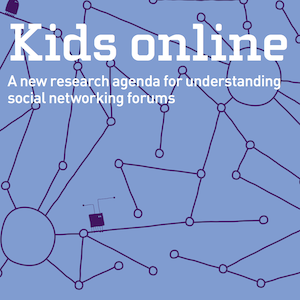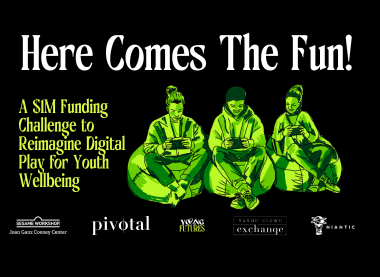
It has been a whirlwind few months for me as I have finished my dissertation, begun my fellowship at the Cooney Center, and, now, am writing my first blog post! One of the big events for me as a Cooney Center fellow so far was attending the JGCC’s “Networked Participation Workshop”, which was funded by the MacArthur Foundation and Cisco Systems. The workshop brought together two dozen representatives from academia and industry who met at Cicso’s New York offices on November 11, 2011 to discuss what is known and what needs to be known about children’s social networking practices online. By children, the group meant kids between the ages of five and twelve.
The day’s discussions were focused around three main topics:
- Children’s meaningful engagement with online social media (the structures, affordances, and dynamics of the sites where children participate)
- The equity of children’s participation (the contexts and conditions under which various forms of participation do and should take place)
- The risks and benefits of children’s participation (the cognitive, emotional, social, and physical impacts of children’s various forms of participation)
Not having previously studied children’s learning from the angle of digital media, I learned a ton from the workshop! The takeaway that resonated the loudest and clearest for me was the need to know so much more about kids’ use of online social media, particularly how younger children use apps and tools as well as how that usage might impact their learning—both positively or negatively.
Along these lines, the assembled presenters and discussants articulated a set of key priorities for future research in this area. Below are just a few of the most powerful points related to our discussion.
(1) Children’s online “social networking” takes place regularly in sites beyond Facebook and MySpace, and involves activities beyond tweeting, “liking,” and posting on friends’ walls.
Kids’ social networking occurs in virtual worlds, interest-driven affinity spaces, and massively multi-player online games, and it takes many forms, including activities like creating or remixing projects on Scratch, determining the cause of a Whypox outbreak in Whyville, or decorating an avatar’s “igloo” in Club Penguin. The various sites and spaces in which children participate have many different structures and interactive features, but they share some important aspects in common such as member profiles and visible connections among members. The tendency within prior research to limit consideration of kids’ online social networking only to sites like Facebook and MySpace and to focus on youth older than 13 (these sites only allow members who are at least 13 years old) has resulted in a gross underestimation of how and how much kids participate in social networking activities. Thus it’s particularly important for researchers working in this area to develop appropriate terminology, typologies, and operational definitions to understand the similarities and differences among online sites and to capture and address the full range of children’s participation within them.
(2) Technology is changing rapidly, yet the developmental needs and abilities of children remain the same.
Social networking certainly did not begin with the birth of the Internet. Developmental psychologist Sandra Calvert (Georgetown University) reminded us that we should use what we know about child development as a framework for analyzing the risks and benefits of kids’ online interactions. This framing can also serve as a guide for informing the design of future social spaces for kids online.
Such a developmental approach can also inform how we examine the specific features of sites and understand how these facilitate certain forms of interaction that may be aiding or impeding kids’ learning. Research by attendee Sandra Okita (Teachers College, Columbia University), for example, explores the ways that children and adolescents across various developmental stages respond to things like robots and virtual avatars. She then applies that knowledge to the design of new video games, virtual realities, and other technologies to further test developmental boundaries.
With thousands of years’ worth of accumulated knowledge about human development, it’s good to remind ourselves that the study of children’s virtual lives should be in tandem with the study of children’s off-line lives.
(3) Some of the most valuable learning opportunities for kids online may include practices that are often not currently valued, and in some cases not even allowed.
In a discussion of equity, UC Berkeley graduate student Christo Sims cautioned against the tendency to approach kids’ online participation in terms of a gap or deficiency model that identifies certain online practices as valuable and beneficial. By definition, those who are not engaging in these behaviors are deemed lacking, or in some cases deviant. Such an approach tends to define the “good” according to what the most privileged kids are doing (i.e., middle- and upper-class boys), which not only overlooks creative alternatives by non-majority kids, but normalizes a small subset of behaviors that can become reified in funding and policy arenas.
One common practice that may be currently undervalued, for example, is friending in online social network spaces. On its face, the practice of accumulating a large number of online connections may seem useless at best and harmful at worst. However, work by Christine Greenhow (University of Maryland) and others has shown that being part of online social networks builds kids’ social capital, which in-turn is associated with a higher tendency to do well in school, graduate high school, and attend college.
What is more, some practices considered deviant or non-conformist may also have benefits for kids. Sara Grimes (University of Toronto) and Deborah Fields (University of Pennsylvania) explained that many forms of rule-breaking in online social space-like developing cheats or workarounds and codehacking-not only require a deep knowledge but also help kids build new knowledge. Even more interesting, a 2007 report from the National School Board Association found that kids who engage in these types of alternative practices tend to have higher-than-average leadership and 21st century skills. These kids also participate more frequently in content creation activities, and are generally closer to their parents and peers though their grades in school tend to be lower than those of their peers. Clearly, the simplistic valuation of kids’ practices in online social networks is inaccurate and potentially misleading. Rather, we need to approach future investigations of the risks and benefits of kids’ networking practices in a more nuanced way.
Finally, attending this workshop reaffirmed for me what an exciting time it is to be a researcher in the field of digital media and learning! There is no shortage of possible avenues of study that can have real impact on children’s lives. Expect much more from the Cooney Center on the topic of kids’ online social behavior, including a full report on this topic by Sara Grimes and Deborah Fields due out in Spring 2012.

